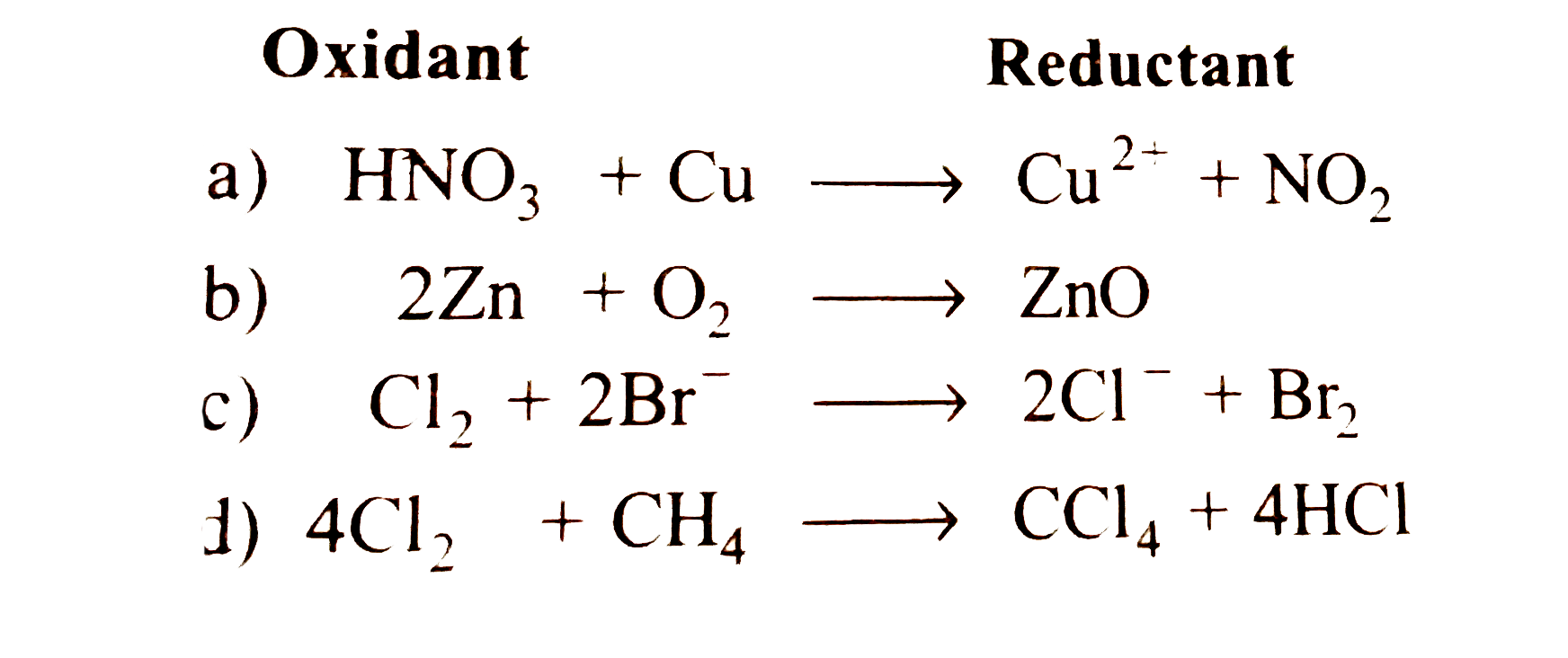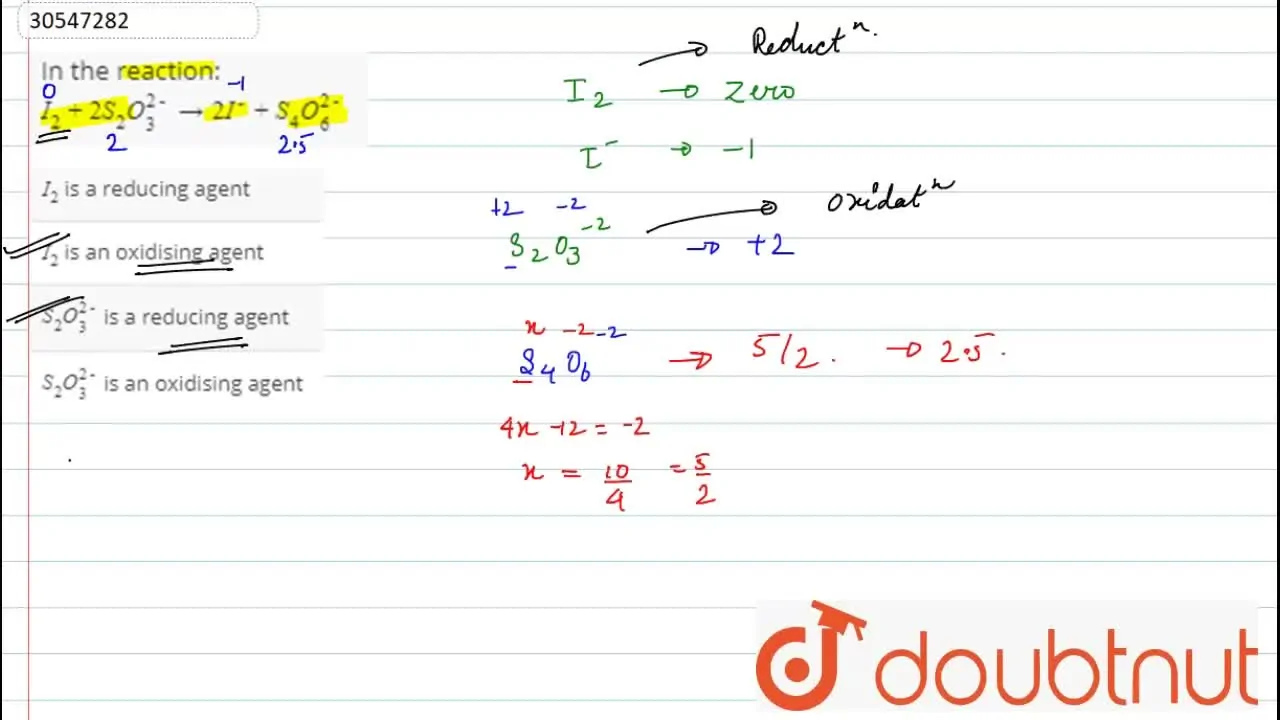Oxidation and reduction process involves the transaction of electrons. Loss of electrons is oxidation and the gain of electrons is reduction. It is thus obvious that in a redox reaction, the oxidant is reduced by accepting the electrons and the reductant is oxidised by losing electrons. The reactions in which a species disproportionates into two oxidation states (lower and higher) are called disproportionation reactions. In electrochemical cells, redox reaction is involved, i.e., oxidation takes place at anode and reduction at cathode.
In the reaction:
I2+2S2O2−3→2I−+S4O2−6
I2 is a reducing agent
I2 is an oxidising agent
S2O2−3 is a reducing agent
S2O2−3 is an oxidising agent
The correct Answer is:B, C
Step by step video, text & image solution for Oxidation and reduction process involves the transaction of electrons. Loss of electrons is oxidation and the gain of electrons is reduction. It is thus obvious that in a redox reaction, the oxidant is reduced by accepting the electrons and the reductant is oxidised by losing electrons. The reactions in which a species disproportionates into two oxidation states (lower and higher) are called disproportionation reactions. In electrochemical cells, redox reaction is involved, i.e., oxidation takes place at anode and reduction at cathode. In the reaction: I_(2)+2S_(2)O_(3)^(2-) to 2I^(-)+S_(4)O_(6)^(2-) by Chemistry experts to help you in doubts & scoring excellent marks in Class 11 exams.
Related Playlists
- BOOK - OP TANDONCHAPTER - OXIDATION AND REDUCTION (REDOX REACTIONS)EXERCISE - Self assignment22videos
OXIDATION AND REDUCTION (REDOX REACTIONS)
- BOOK - OP TANDONCHAPTER - OXIDATION AND REDUCTION (REDOX REACTIONS)EXERCISE - SECTION V3videos
OXIDATION AND REDUCTION (REDOX REACTIONS)
- BOOK - OP TANDONCHAPTER - OXIDATION AND REDUCTION (REDOX REACTIONS)EXERCISE - INTEGER TYPE11videos
OXIDATION AND REDUCTION (REDOX REACTIONS)
- BOOK - OP TANDONCHAPTER - MISCELLANEOUS (TOPICS OF GENERAL INTEREST)EXERCISE - SET-VI: Problems on graphical aptitude53videos
MISCELLANEOUS (TOPICS OF GENERAL INTEREST)
- BOOK - OP TANDONCHAPTER - POLYMERSEXERCISE - PASSAGE 35videos
POLYMERS
Similar Questions
Oxidation and reduction process involves the transaction of electrons. Loss of electrons is oxidation and the gain of electrons is reduction. It is thus obvious that in a redox reaction, the oxidant is reduced by accepting the electrons and the reductant is oxidised by losing electrons. The reactions in which a species disproportionates into two oxidation states (lower and higher) are called disproportionation reactions. In electrochemical cells, redox reaction is involved, i.e., oxidation takes place at anode and reduction at cathode.
The reaction Cl2→Cl−+ClO−3 is:View SolutionOxidation and reduction process involves the transaction of electrons. Loss of electrons is oxidation and the gain of electrons is reduction. It is thus obvious that in a redox reaction, the oxidant is reduced by accepting the electrons and the reductant is oxidised by losing electrons. The reactions in which a species disproportionates into two oxidation states (lower and higher) are called disproportionation reactions. In electrochemical cells, redox reaction is involved, i.e., oxidation takes place at anode and reduction at cathode.
Select the correct statement:View SolutionOxidation and reduction process involves the transaction of electrons. Loss of electrons is oxidation and the gain of electrons is reduction. It is thus obvious that in a redox reaction, the oxidant is reduced by accepting the electrons and the reductant is oxidised by losing electrons. The reactions in which a species disproportionates into two oxidation states (lower and higher) are called disproportionation reactions. In electrochemical cells, redox reaction is involved, i.e., oxidation takes place at anode and reduction at cathode.
Which of the following reactions is/are correctly indicated?
 View Solution
View SolutionOxidation and reduction process involves the transaction of electrons. Loss of electrons is oxidation and the gain of electrons is reduction. It is thus obvious that in a redox reaction, the oxidant is reduced by accepting the electrons and the reductant is oxidised by losing electrons. The reactions in which a species disproportionates into two oxidation states (lower and higher) are called disproportionation reactions. In electrochemical cells, redox reaction is involved, i.e., oxidation takes place at anode and reduction at cathode.
Detennine the change in oxidation number of sulphur in H2SandSO2 respectively in the following reaction:
2H2S+SO2→2H2O+3SView SolutionOxidation reaction involves loss of electrons, and reduction reaction involves gain of electrons. The reaction in which a species disproportinates into two oxidation states ( lower and higher) is called disproportionation reaction.
Which of the following statements is wrong?View SolutionOxidation reaction involves loss of electrons, and reduction reaction involves gain of electrons. The reaction in which a species disproportinates into two oxidation states ( lower and higher) is called disproportionation reaction.
Which of the following statements is wrong?View SolutionOxidation reaction involves loss of electrons, and reduction reaction involves gain of electrons. The reaction in which a species disproportinates into two oxidation states ( lower and higher) is called disproportionation reaction.
Which of the following statements is wrong?View SolutionOxidation reaction involves loss of electrons, and reduction reaction involves gain of electrons. The reaction in which a species disproportinates into two oxidation states ( lower and higher) is called disproportionation reaction.
Which of the following statements is correct?View SolutionOxidation reaction involves loss of electrons, and reduction reaction involves gain of electrons. The reaction in which a species disproportinates into two oxidation states ( lower and higher) is called disproportionation reaction.
Which of the following is not a dispropotional reaction?View SolutionOxidation and Reduction Reactions
View Solution


